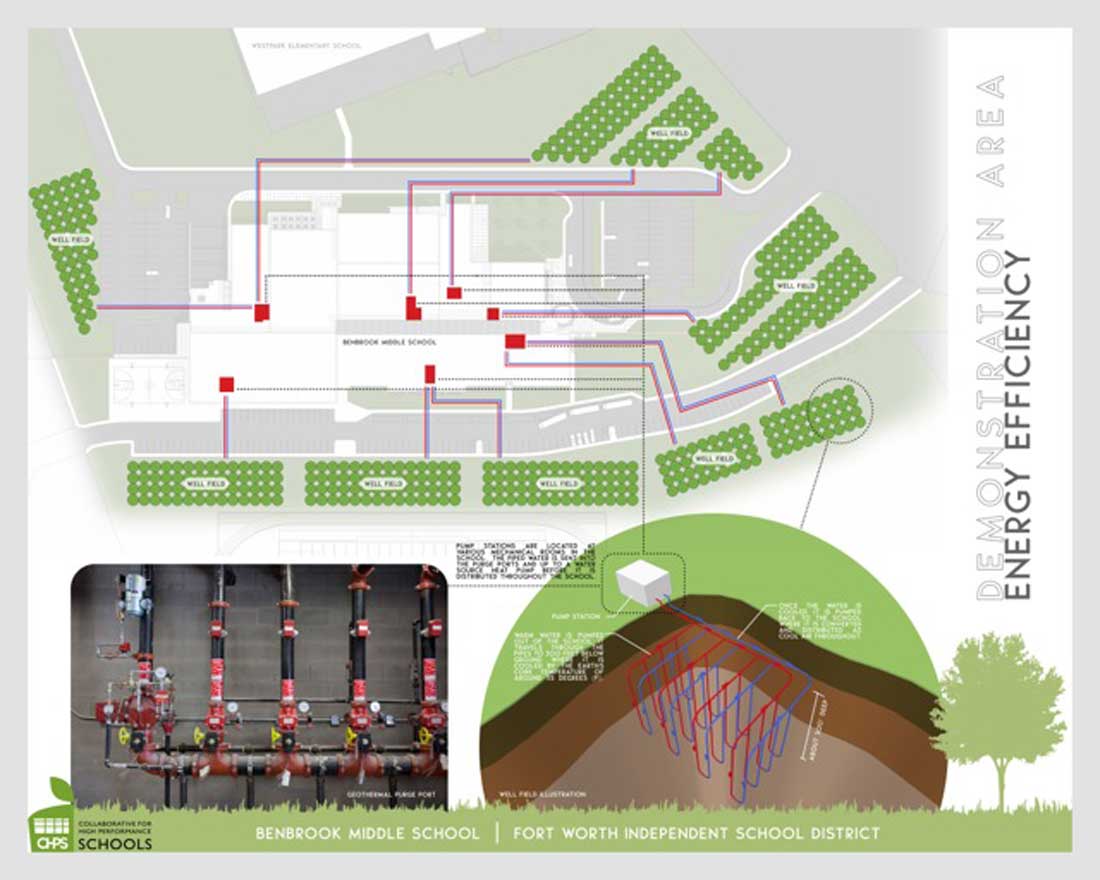From Highway 377, Benbrook Middle School looks out of place. The modern-looking, brown-and-cream-colored structure stands in stark contrast to the cattle pasture across the street and the myriad strip malls dotting the landscape on the highway. Inside, the hallways have high ceilings and windows that bathe the interior in natural light. The massive auditorium could easily be mistaken for a concert venue, and the basketball gym looks spotless. As far as middle schools go, the two-year-old campus is a cathedral.
But what makes the school even more remarkable is what lies beneath it. Benbrook Middle School, which opened in 2011, is one of five newly constructed campuses in the Fort Worth school district that use geothermal energy for heating and cooling. All of the new campuses built over the last three years have geothermal systems, and future school buildings will have the system as well, said district officials.
Funds for Benbrook and the four other geothermal schools (Rosemont, Hazel Harvey Peace, and John T. White elementary schools and Jean McClung Middle School) came from the $593.6 million bond package approved by voters in November 2007.
“This recent bond program was all about sustainability, to make sure that we were doing the right thing environmentally [and] also providing the best [campuses] for our kids,” said School Superintendent Walter Dansby.
A geothermal system uses the relatively stable temperature of the earth’s crust as a heat source in winter and as a heat sink in summer. Hundreds of little wells are dug in the areas around the schools, and the water is pumped into the earth before being carried to the building through a series of pipes and circulated throughout. Benbrook Middle School has 11 well fields, with hundreds of tiny wells. One of the fields lies beneath a green area near the school’s track and football field. Others sit beneath its parking lots.
Don Penn, a consulting engineer for IEG, a Grapevine-based engineering firm, oversaw the installation of the systems. He said the geothermal system is a lot like a conventional system, but it uses a water pump instead of a fan to transfer energy.
“We utilize the earth as a heat source,” he said. “The water in the earth is 70 degrees in this area, so we have a 70-degree heat source, or thermal resource, to either pull heat out of the ground in the winter or put it back in the summer. … We also store that energy season to season.”
Geothermal energy is less expensive than conventional systems and has virtually no emissions or carbon footprint. Penn, whose company has overseen the installation of more than 200 such systems in North Texas, said there is generally a 30 percent savings in utility bills in elementary schools and 50 percent in high schools. The new schools in the Fort Worth school district have not been open long enough to collect enough data to get exact figures, he said.
In terms of environmental impact, Penn said that each campus will reduce its carbon dioxide output by more than100 metric tons per year.
In 2007, as deputy superintendent, Dansby oversaw the day-to-day implementation of construction projects and budgets related to the bond package. He said he got the idea to use geothermal systems from Keller’s school district, which has several geothermal schools.
“We got with our maintenance staff and asked them to look at other school districts, to review how they were utilizing geothermal, as we were developing our bond program,” he said. “And our maintenance guys thought it was a great idea based on what they found.”
He said the system has more benefits than just being cost-efficient and environmentally sound. “It’s very quiet, it is very efficient, it’s very conducive to a learning atmosphere for the kids,” he said.
There’s also an added benefit, he said. “I think our roofs are going to last much longer because there’s not going to be as much activity on them, as there is with [maintaining] traditional rooftop [heating and cooling] units.”
Penn said another advantage is that the energy source is renewable, so maintaining the system is cost-efficient. “The life of the well field is infinite,” he said. “The replacement cost down the road is cheaper than anything else out there.”
Kristabel Lopez, a program manager for AECOM, a company that manages the district’s capital improvement program, said that the geothermal schools also present a learning opportunity for students, who often hear words like “sustainable” and “energy-efficient” but rarely have a chance to put those concepts into context.
“Under Mr. Dansby’s philosophy for the bond program in 2007, geothermal was a component of a bigger view, which was about sustainability and environmentally friendly schools,” Lopez said.
The program, she continued, allows the district to “offer to the community that idea and a building where students could learn about those concepts they were hearing about.”
Geothermal buildings such as Benbrook Middle School also use natural light during the day to reduce the utility costs, decorate the landscape with native plants, and use water-efficient sprinkler systems.
At Benbrook Middle School, posters explain how the geothermal system works and detail its benefits. Students also learn about it in the classroom. One sixth-grade science project is to design a plan to manage energy resources in students’ homes, school, or community and prepare a proposal to present to the Benbrook mayor and chamber about the advantages of converting the adjacent Westpark Elementary School to a similar system.
Dansby said that he and other district officials are discussing retrofitting existing schools with geothermal systems. But, he said, it’s difficult because geothermal systems require a lot of land for the wells. “In Fort Worth ISD, we’re landlocked.”
The land, Penn said, “has to be equal to the size of the land you are air conditioning. If you have a 100,000-square-foot school, you’d need 100,000 square feet of land.”
Lopez said the systems have been so successful in reducing costs that, going forward, all schools built by the district will use geothermal systems.
“We just completed the update of the district’s design guidelines,” she said. “All schools in the foreseeable future will have geothermal systems.”
The district also has reduced its utility costs by using the new geothermal campuses for training and special events. “We use them a lot,” Dansby said. “We realize savings there because we use them instead of other, [less efficient] facilities.”
Stojan Trickovich, energy manager for the school district, is in charge of generating reports on energy and energy savings. He said everyone involved in the project is extremely proud of the geothermal schools and how much money they save the district. “All five geothermal schools … save so much money,” he said. “That’s a fabulous achievement for the district.”













This is the first I’ve heard about how the new bond money would go to build Geothermal schools! Am I missing something? Nowhere in the original bond proposal, nor the updated 3 tier proposal, did the district mention “Geothermal” anything!!! This article is only endorsing Dansby, not what it will do to promote the success of our students! Come on Weekly, why did you all cave and publish this rubbish? It is now more obvious that our district and board are anxious to pass this bond to line their pockets in kick-back $, first with AECOM and now with IEG. The original bond proposal sounded ludicrous; the 3 tier bond sounded even more farfetched and scrambled…now you want to tell me Dansby handled the previous bond and would do a bang up job this go-around too? If he did such a great job, why can’t anyone seem to explain what happened to the 90 million surpluses from that bond package he managed so well?! Eric, I know you publish what is approved, so I am not blaming this puff piece on you! However, can you explain to your boss that Dansby is using your paper for political and personal gain? This is the same man, who has been very vocal for the last 3 years about trashing “The Weekly” and former journalist, Betty Brink, for writing the truth about the district. All of sudden, we are to feel like, and I will use a recent quote from a leaked audio, “holding hands with Dansby and sing Kumbaya”? No thanks! Many of us will wait to do that…when pigs fly!
This is one of Walter Dansby’s true successes. Let’s give credit where it’s due. The failure to publicize the last bond’s geothermal schools shouldn’t be held against the board. Hazel Harvey Peace in District 6, plus Middle School Jean McClung plus John T. White are the ones which come to my mind right now are all geothermal.
Ann: Take your damn meds! Better yet, let us take them, so we can stomach the brown nose BS you share about Danby! You’re starting to mirror Needham in SO many ways! “Pee or get off the pot.”
Listen.
Can you hear it?
Flip Flop; Flip Flop; Flip Flop. Flip Flop.
If this is “his one true success” what in the hell is he doing as Superintendent? He sure doesn’t know jack about education!!
Blah, Blah, Blah. Yawn. Lawsuits, audio leaks, scandal after scandal, nepotism, promoting dozens beyond their capability, turning on those who supported you, allowing your former GF to promote someone fired for fraud and nepotism in DISD, and the continuing decline of our schools. Yet THIS is the best Dansby can say about himself. I almost was not going to comment at all. Where is the $90 million? Where is the $90 million? Where is the $90 million? We may have green buildings, but our kids are still sitting in broken desks if they have desks at all. Time for this clown to go.
I’m pretty sure this article is discussing items executed in the 2007 bond. And the $90m surplus did go back into our schools. Including the $11m+ addition to Northside HS among other projects. It is pretty clearly spelled out on the district’s website where the money went. I’m usually the first to criticize the district for their shortcomings, but I am glad to see that they actually did implement some of the sustainable steps that they promised in ’07. Hopefully they will carry on that tradition with this new bond, and that they will actually send some more love to the North Side.
What a joke.
Teachers need to begin to rally (quietly of course) against this train wreck and robbery.
This is great news! I commend the Fort Worth ISD for implementing these and other sustainable measures in their new buildings. Please keep us informed about the operational savings resulting from these installations and other curriculum benefits. I encourage the district to look for ways to implement green features in existing schools when it makes sense. I enjoy the article. Great article!
What misplaced priorities. “Great news” indeed. Kids literally falling out of broken desks that should have been replaced during the last Bond – but we have a “green school”. Obviously written by a moron working for FWISD without kids in the classroom.
I know personally, at least 5 teachers who don’t have enough desks for their students. Kids are sitting in chairs trying to write or on the floor. Many are in desks that are so badly damaged they should have been junked years ago. Oh but we have some green schools. YEA. Ann why don’t you fight for the kids instead of jumping from one side to the other. It must be exhausting trying to decide which side you are on on any given day.
Time to expose the biggest Bond rumor of the past 90 days: supposedly the construction contract has already been promised to none other than Issac Manning (Dickerson’ buddy and partner in “Citizens for Great Schools”) by none other than Walter Dansby – self styled guru of Bond issues. Funny. How could that be? We don’t even know what work is to be done – the vote is not in. Not to let details get in the way…… Dansby knows how to by-pass the small stuff like bidding and transparency.